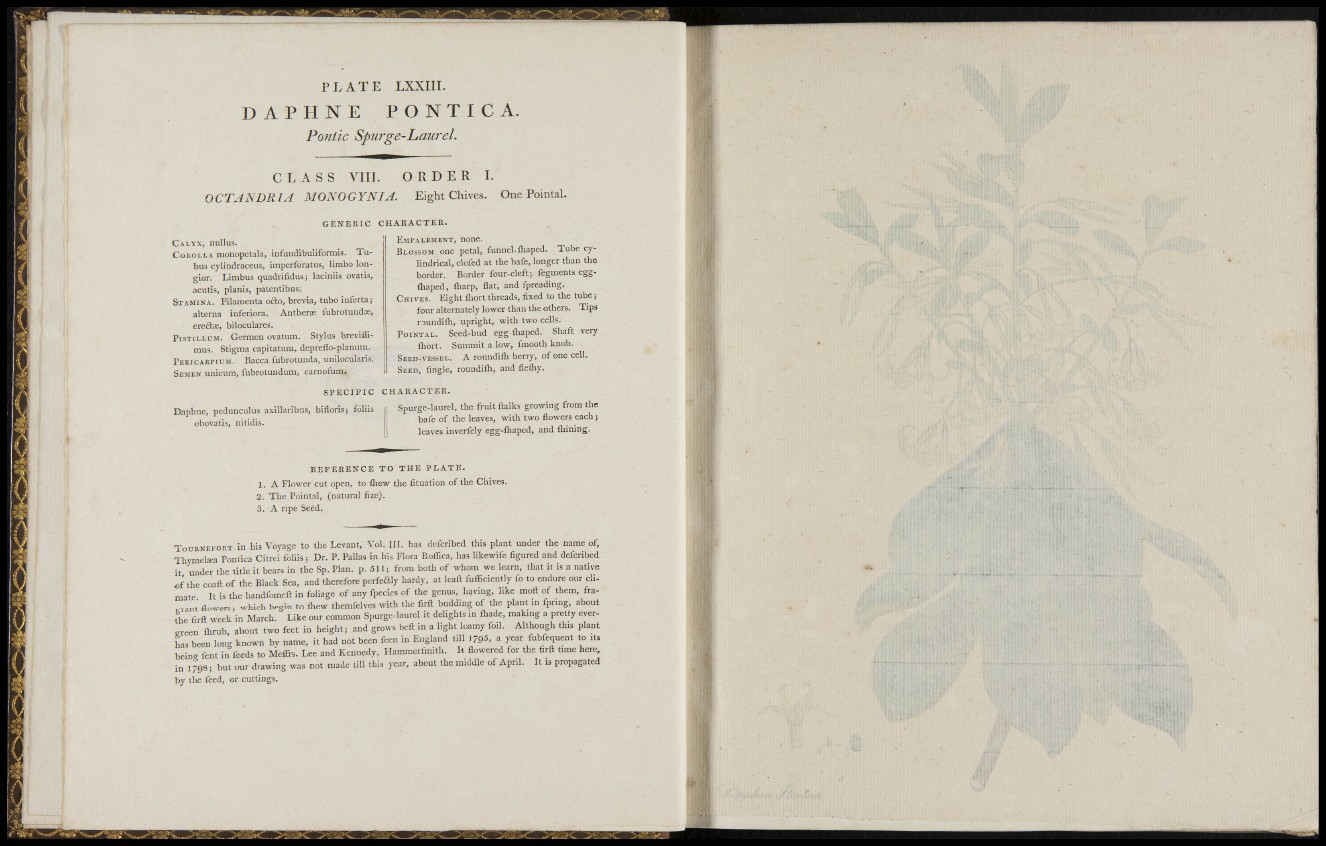
P L A T E LXXIII.
D A P H N E PONTIC A.
Pontic Spurge-haureL
C L A S S VIIL ORDER L
OCTANDRIA MONOGYNIA. Eight Chives. One Pointal.
G E N E R I C CHARACTER.
CALYX, nullus.
COROLLA monopetala, infuiidibuliformis. Tubus
cyliudraceus, imperforatus, limbo loiigior.
Limbus quadrifidus; laciniis ovatis,
acutis, planis, patentibus.
STAMINA. Filamenta odo, brevia, tubo inferta;
alterna inferiora. Antherae. fubrotuuda:,
erefiEe, biloculares.
PisTiLLUM. Germen ovatum. Stylus breviflimus.
Stigma capitatum, depreño-planum.
PERICARPIUM. Bacca fubrotunda, unilocularis.
SEMEN unicum, fubrotundum, carnofum.
EMFALEMENT, none.
BLOSSOM one petal, funnel-fliaped. Tube cylindrical,
clofed at the bafe, longer than the
border. Border four-cleft; fegments eggflwped,
(liarp, flat, and fpreading.
CHIVES. Eight fliort thread.s, lixed to the tube;
four alternately lower than the others. Tips
rounditli, upright, with two cells.
P O I N T A L . Seed-bud egg-iliaped. Shaft very
fliort. Summit a low, fmooth knob.
SEED-VESSEL. A roundifli berry, of one cell.
SEED, fingle, roundifli, and fiefliy.
S P E C I F I C CHARACTER.
Daphne, pedunculns axillaribus, bifloris; foliis
obovatis, nitidis.
Spurge-laurel, the fruit ilalks growing from the
bafe of the leaves, with two flowers each;
leaves inverfely egg-fliaped, and Ihining.
R E F E R E N C E T O THE PLATE.
1. A Flower cut open, to fliew the fituation of the Chives.
2. The Pointal, (natural fize).
3. A ripe Seed.
T O U E N E F O R T in his Voyage to the Levant, Vol. III. has defcribed this plant under the name of,
Thymeliea Pontica Citrei foliis; Dr. P. Pallas in his Flora Roffica, has likewife figured and defcribed
it under the title it bears in the Sp. Plan. p. 511; from both of whom we learn, that it is a native
of the coaft of the Black Sea, and therefore perfectly hardy, at leaft fufliciently fo to endure our climate
It is the handfomeft in foliage of any fpecles of the genus, having, like moft of them, fragrant
flowers- which begin to fliew themfelves with the firft budding of the plant in fpnng, about
th^ firft week in March. Like our common Spurge-laurel it delights in ihade, making a pretty evergreen
Ihrub, about two feet in height; and grows beft in a light loamy foil. Although this plant
has been long known bv name, it had not been feen in England till y pS. a year fubfequent to its
bein.. fent in feeds to Meffrs. Lee and Kennedy, Hammerfmith. It flowered for the firft time here,
in 1798; but our drawing was not made till this year, about the middle of April. It is propagated
by the feed, or cuttings.